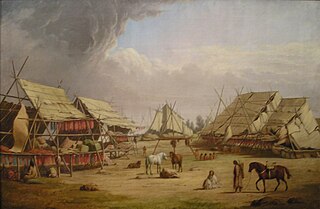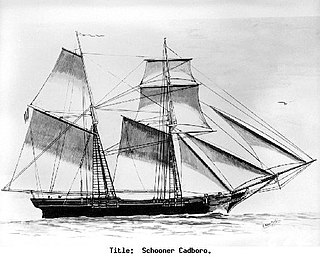
Fort Vancouver was a 19th century fur trading post that was the headquarters of the Hudson's Bay Company's Columbia Department, located in the Pacific Northwest. Named for Captain George Vancouver, the fort was located on the northern bank of the Columbia River in present-day Vancouver, Washington. The fort was a major center of the regional fur trading. Every year trade goods and supplies from London arrived either via ships sailing to the Pacific Ocean or overland from Hudson Bay via the York Factory Express. Supplies and trade goods were exchanged with a plethora of Indigenous cultures for fur pelts. Furs from Fort Vancouver were often shipped to the Chinese port of Guangzhou where they were traded for Chinese manufactured goods for sale in the United Kingdom. At its pinnacle, Fort Vancouver watched over 34 outposts, 24 ports, six ships, and 600 employees. Today, a full-scale replica of the fort, with internal buildings, has been constructed and is open to the public as Fort Vancouver National Historic Site.

Chinookan peoples include several groups of Indigenous people of the Pacific Northwest in the United States who speak the Chinookan languages. Since at least 4000 BCE Chinookan peoples have resided along the Lower and Middle Columbia River (Wimahl) from the river's gorge downstream (west) to the river's mouth, and along adjacent portions of the coasts, from Tillamook Head of present-day Oregon in the south, north to Willapa Bay in southwest Washington. In 1805 the Lewis and Clark Expedition encountered the Chinook Tribe on the lower Columbia.

Fort Astoria was the primary fur trading post of John Jacob Astor's Pacific Fur Company (PFC). A maritime contingent of PFC staff was sent on board the Tonquin, while another party traveled overland from St. Louis. This land based group later became known as the Astor Expedition. Built at the entrance of the Columbia River in 1811, Fort Astoria was the first American-owned settlement on the Pacific coast of North America.

Peter Skene Ogden was a British-Canadian fur trader and an early explorer of what is now British Columbia and the Western United States. During his many expeditions, he explored parts of Oregon, Washington, Nevada, California, Utah, Idaho, and Wyoming. Despite early confrontations with the Hudson's Bay Company (HBC) while working for the North West Company, he later became a senior official in the operations of the HBC's Columbia Department, serving as manager of Fort Simpson and similar posts.

The trade center Fort Colvile was built by the Hudson's Bay Company (HBC) at Kettle Falls on the Columbia River in 1825 and operated in the Columbia fur district of the company. Named for Andrew Colvile, a London governor of the HBC, the fort was a few miles west of the present site of Colville, Washington. It was an important stop on the York Factory Express trade route to London via the Hudson Bay. The HBC for some time considered Fort Colvile second in importance only to Fort Vancouver, near the mouth of the Columbia, until the foundation of Fort Victoria.

The Columbia District was a fur trading district in the Pacific Northwest region of British North America in the 19th century. Much of its territory overlapped with the disputed Oregon Country. It was explored by the North West Company between 1793 and 1811, and established as an operating fur district around 1810. The North West Company was absorbed into the Hudson's Bay Company in 1821 under which the Columbia District became known as the Columbia Department. The Oregon Treaty of 1846 marked the effective end of the Hudson's Bay Company's Columbia Department.

Fort Okanogan was founded in 1811 on the confluence of the Okanogan and Columbia Rivers as a fur trade outpost. Originally built for John Jacob Astor’s Pacific Fur Company, it was the first American-owned settlement within Washington state, located in what is now Okanogan County. The North West Company, the PFC's primary competitor, purchased its assets and posts in 1813. In 1821 the North West Company was merged into Hudson's Bay Company, which took over operation of Fort Okanogan as part of its Columbia District. The fort was an important stop on the York Factory Express trade route to London via Hudson Bay.

Oregon pioneer history (1806–1890) is the period in the history of Oregon Country and Oregon Territory, in the present day state of Oregon and Northwestern United States.
Fort William was a fur trading outpost built in 1834 by the American Nathaniel Jarvis Wyeth, a Boston merchant, backed by American investors. It was located on the Columbia River on Wappatoo Island near the future Portland, Oregon. After a few years, in 1837 Wyeth sold the post to the British Hudson’s Bay Company, which had much more power in the region from its base at Fort Vancouver on the north side of the Columbia River near Fort William.

Comcomly was a Native American leader of the Lower Chinook, a group of Chinookan peoples indigenous to the Pacific Northwest, who inhabited the area near Ilwaco, Washington. Concomly spoke Lower Chinook and was known for his skill with diplomacy and trade.
Joseph Gervais was a French-Canadian, later American, pioneer settler and trapper in the Pacific Northwest. He is the namesake for the town of Gervais, Oregon.

Cadboro was a schooner launched at Rye, England, in 1824. The Hudson's Bay Company purchased her in 1826 and sold her in 1860. She grounded just north of Port Angeles, WA in October 1962 and was destroyed by pounding surf shortly thereafter.
Thomas McKay (1796–1849) was an Anglo-Métis Canadian fur trader who worked mainly in the Pacific Northwest for the Pacific Fur Company (PFC), the North West Company (NWC), and the Hudson's Bay Company (HBC). He was a fur brigade leader and explorer of the Columbia District and later became a U.S. citizen and an early settler of Oregon.
Columbia was a barque launched in 1835 in London for the Hudson's Bay Company (HBC). She served in the service of the Columbia District of the HBC on the Columbia River and elsewhere in the Pacific Northwest in the 1830s and 1840s.
Many ships have borne the name Isabella:
Isabella Mainville Ross was the first female registered landowner in British Columbia. She was a Métis woman, the daughter of Joseph and Josette Mainville.

Eddystone was launched at Hull in 1802. She then sailed for the North West Company. The French Navy captured her in 1806 but an armed ship of the Royal Navy recaptured her within weeks. She next sailed for the Hudson's Bay Company (HBC) from 1807 to about 1824. She then traded generally until May 1843 when she was wrecked.
Queen Charlotte was built on the Thames in 1790. She made eight voyages for the Hudson's Bay Company (HBC) before it sold her in 1800. She then traded to South America and the Mediterranean. In 1803 her crew mutinied and turned her over to the French, who promptly handed her and them back to the British authorities, despite the two countries being at war. She then spent much of her career sailing between London and the Cape of Good Hope. She was sailing for the Cape in October 1813 when a collision with another vessel resulted in Queen Charlotte being wrecked shortly thereafter.
William and Ann was launched in Bermuda in 1818. In 1824 the Hudson's Bay Company (HBC) purchased William and Ann. In 1825 she became the first HBC vessel to trade with the Pacific Northwest, competing directly with the Boston fur traders. She made three voyages to Fort George on the Columbia River, and was lost on 10 March 1829 on her fourth as she was arriving there.
Sea Horse was launched in 1782 at Gravesend for the Hudson's Bay Company. She then became a merchantman that a French naval squadron captured in 1795. She next became the Spanish merchantman Principe Fernando, which a Guernsey privateer recaptured in January 1800. She became a merchantman again, and then made one voyage as a whaler. She became a Government transport and it was as a transport that she was wrecked in 1816 with great loss of life.










